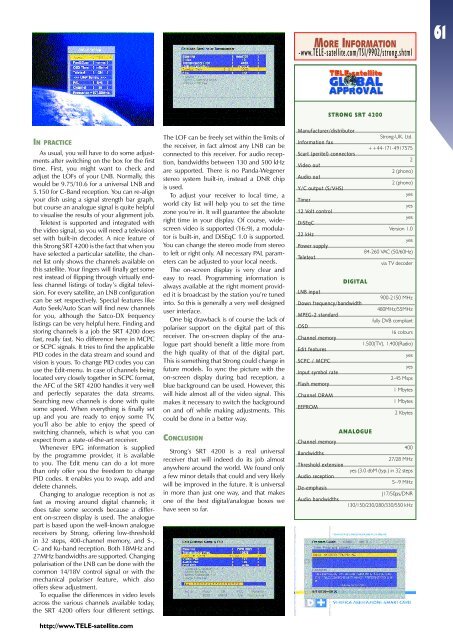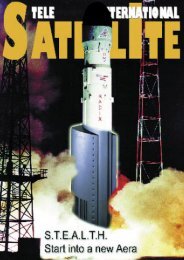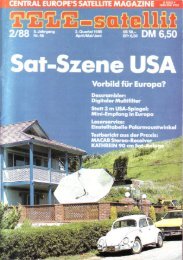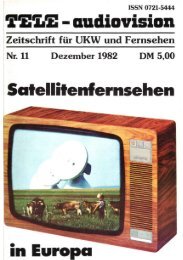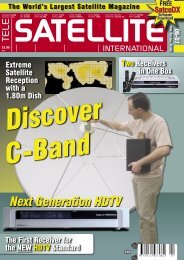Bestellen Sie diesen Satelliten- Newsletter! - TELE-satellite ...
Bestellen Sie diesen Satelliten- Newsletter! - TELE-satellite ...
Bestellen Sie diesen Satelliten- Newsletter! - TELE-satellite ...
Create successful ePaper yourself
Turn your PDF publications into a flip-book with our unique Google optimized e-Paper software.
IN PRACTICE<br />
As usual, you will have to do some adjustments<br />
after switching on the box for the first<br />
time. First, you might want to check and<br />
adjust the LOFs of your LNB. Normally, this<br />
would be 9.75/10.6 for a universal LNB and<br />
5.150 for C-Band reception. You can re-align<br />
your dish using a signal strength bar graph,<br />
but course an analogue signal is quite helpful<br />
to visualise the results of your alignment job.<br />
Teletext is supported and integrated with<br />
the video signal, so you will need a television<br />
set with built-in decoder. A nice feature of<br />
this Strong SRT 4200 is the fact that when you<br />
have selected a particular <strong>satellite</strong>, the channel<br />
list only shows the channels available on<br />
this <strong>satellite</strong>. Your fingers will finally get some<br />
rest instead of flipping through virtually endless<br />
channel listings of today’s digital television.<br />
For every <strong>satellite</strong>, an LNB configuration<br />
can be set respectively. Special features like<br />
Auto Seek/Auto Scan will find new channels<br />
for you, although the Satco-DX frequency<br />
listings can be very helpful here. Finding and<br />
storing channels is a job the SRT 4200 does<br />
fast, really fast. No difference here in MCPC<br />
or SCPC signals. It tries to find the applicable<br />
PID codes in the data stream and sound and<br />
vision is yours. To change PID codes you can<br />
use the Edit-menu. In case of channels being<br />
located very closely together in SCPC format,<br />
the AFC of the SRT 4200 handles it very well<br />
and perfectly separates the data streams.<br />
Searching new channels is done with quite<br />
some speed. When everything is finally set<br />
up and you are ready to enjoy some TV,<br />
you’ll also be able to enjoy the speed of<br />
switching channels, which is what you can<br />
expect from a state-of-the-art receiver.<br />
Whenever EPG information is supplied<br />
by the programme provider, it is available<br />
to you. The Edit menu can do a lot more<br />
than only offer you the freedom to change<br />
PID codes. It enables you to swap, add and<br />
delete channels.<br />
Changing to analogue reception is not as<br />
fast as moving around digital channels; it<br />
does take some seconds because a different<br />
on-screen display is used. The analogue<br />
part is based upon the well-known analogue<br />
receivers by Strong, offering low-threshold<br />
in 32 steps, 400-channel memory, and S-,<br />
C- and Ku-band reception. Both 18MHz and<br />
27MHz bandwidths are supported. Changing<br />
polarisation of the LNB can be done with the<br />
common 14/18V control signal or with the<br />
mechanical polariser feature, which also<br />
offers skew adjustment.<br />
To equalise the differences in video levels<br />
across the various channels available today,<br />
the SRT 4200 offers four different settings.<br />
http://www.<strong>TELE</strong>-<strong>satellite</strong>.com<br />
The LOF can be freely set within the limits of<br />
the receiver, in fact almost any LNB can be<br />
connected to this receiver. For audio reception,<br />
bandwidths between 130 and 500 kHz<br />
are supported. There is no Panda-Wegener<br />
stereo system built-in, instead a DNR chip<br />
is used.<br />
To adjust your receiver to local time, a<br />
world city list will help you to set the time<br />
zone you’re in. It will guarantee the absolute<br />
right time in your display. Of course, widescreen<br />
video is supported (16:9), a modulator<br />
is built-in, and DiSEqC 1.0 is supported.<br />
You can change the stereo mode from stereo<br />
to left or right only. All necessary PAL parameters<br />
can be adjusted to your local needs.<br />
The on-screen display is very clear and<br />
easy to read. Programming information is<br />
always available at the right moment provided<br />
it is broadcast by the station you’re tuned<br />
into. So this is generally a very well designed<br />
user interface.<br />
One big drawback is of course the lack of<br />
polariser support on the digital part of this<br />
receiver. The on-screen display of the analogue<br />
part should benefit a little more from<br />
the high quality of that of the digital part.<br />
This is something that Strong could change in<br />
future models. To sync the picture with the<br />
on-screen display during bad reception, a<br />
blue background can be used. However, this<br />
will hide almost all of the video signal. This<br />
makes it necessary to switch the background<br />
on and off while making adjustments. This<br />
could be done in a better way.<br />
CONCLUSION<br />
Strong’s SRT 4200 is a real universal<br />
receiver that will indeed do its job almost<br />
anywhere around the world. We found only<br />
a few minor details that could and very likely<br />
will be improved in the future. It is universal<br />
in more than just one way, and that makes<br />
one of the best digital/analogue boxes we<br />
have seen so far.<br />
MORE INFORMATION<br />
-www.<strong>TELE</strong>-<strong>satellite</strong>.com/TSI/9902/strong.shtml<br />
Manufacturer/distributor<br />
Information fax<br />
Scart (peritel) connectors<br />
Video out<br />
Audio out<br />
Y/C output (S/VHS)<br />
Timer<br />
12 Volt control<br />
DiSEqC<br />
22 kHz<br />
Power supply<br />
Teletext<br />
LNB input<br />
STRONG SRT 4200<br />
DIGITAL<br />
Down frequency/bandwidth<br />
MPEG-2 standard<br />
OSD<br />
Channel memory<br />
Edit features<br />
SCPC / MCPC<br />
Input symbol rate<br />
Flash memory<br />
Channel DRAM<br />
EEPROM<br />
Channel memory<br />
Bandwidths<br />
Threshold extension<br />
Audio reception<br />
De-emphasis<br />
Audio bandwidths<br />
ANALOGUE<br />
Strong-UK, Ltd.<br />
++44-171-4917575<br />
2<br />
2 (phono)<br />
2 (phono)<br />
yes<br />
yes<br />
yes<br />
Version 1.0<br />
yes<br />
84-260 VAC (50/60Hz)<br />
via TV decoder<br />
900-2150 MHz<br />
480MHz/55MHz<br />
fully DVB compliant<br />
16 colours<br />
1.500(TV), 1.400(Radio)<br />
yes<br />
yes<br />
2-45 Msps<br />
1 Mbytes<br />
1 Mbytes<br />
2 Kbytes<br />
400<br />
27/28 MHz<br />
yes (3.0 dbM (typ.) in 32 steps<br />
5--9 MHz<br />
J17/50µs/DNR<br />
130/150/230/280/330/550 kHz<br />
61


